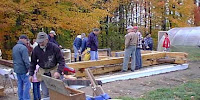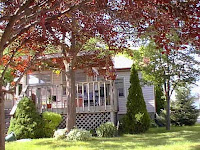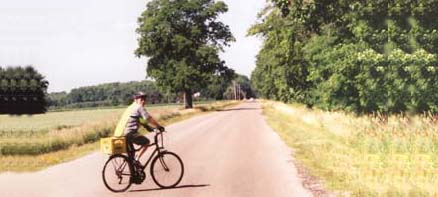 I love the idea of “pitching in”.
I love the idea of “pitching in”.When asked to help with a project, I usually jump in offering whatever I can. More often than not it’s a “2-for” as I volunteer Robin too. In return, I expect a genuine appreciation for the offer and respect for my offering.
We recently participated in a small scale barn-raising at Orchard Hill as farm friends gathered together, raising the structure for a pier & beam, straw bale cabin. Sitting on a concrete foundation, the two story structure (a future home for the farm apprentices) incorporates passive solar radiant sub-floor heating. The majority of the materials, from the hand-hewn beams to the straw bales, were drawn from the farm.
Of course I’m not writing about cabins or construction or even sustainable living. I’m writing about a rare, genuine sense of community; a community of which I am privileged to be a part. Like
 This energy was hard at work as 50 or so folks were joined in a harmonious group effort. Under a moody sky and amid leaf-filled gusts, I watched as leaders led, workers worked, and children played.
This energy was hard at work as 50 or so folks were joined in a harmonious group effort. Under a moody sky and amid leaf-filled gusts, I watched as leaders led, workers worked, and children played.  Upon breaking for lunch, we joined hands in a silent prayer then each took a seat on our straw bale chairs, enjoying the food and company. (I loved my cheesy-crunchy mac and cheese, roasted veggies, coleslaw, green beans with pesto, tomatoe/black olive/feta tart, some of Robin’s salad and fresh bread, followed by tea, pumpkin-carrot cake and chocolate-covered-almond-peanut clusters).
Upon breaking for lunch, we joined hands in a silent prayer then each took a seat on our straw bale chairs, enjoying the food and company. (I loved my cheesy-crunchy mac and cheese, roasted veggies, coleslaw, green beans with pesto, tomatoe/black olive/feta tart, some of Robin’s salad and fresh bread, followed by tea, pumpkin-carrot cake and chocolate-covered-almond-peanut clusters).
 Though we were unable to elevate as much of the structure as we would have liked, the day was a wonderful success for me as my spirit was raised once again. Raised simply by being in an environment of respect and gratitude.
Though we were unable to elevate as much of the structure as we would have liked, the day was a wonderful success for me as my spirit was raised once again. Raised simply by being in an environment of respect and gratitude.



























